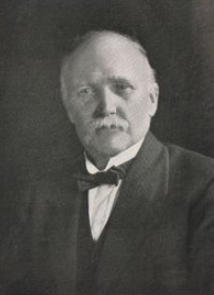James Brown, OBE, DL (16 December 1862 – 21 March 1939) was a Scottish Labour politician.
James Brown | |
|---|---|
 James Brown c. 1931 | |
| Member of Parliament for Ayrshire South | |
| In office 14 December 1918 – 27 October 1931 | |
| Preceded by | William Beale |
| Succeeded by | James MacAndrew |
| In office 14 November 1935 – 21 March 1939 | |
| Preceded by | James MacAndrew |
| Succeeded by | Alexander Sloan |
| Personal details | |
| Born | 16 December 1862 Whitletts, Ayrshire, Scotland |
| Died | 21 March 1939 (aged 76) Ayr, Ayrshire, Scotland |
| Political party | Labour |
| Spouse |
Catherine MacGregor Steel
(m. 1888) |
Early life
editJames Brown was born in the Whitletts area of Ayr, to James Brown (1839-1895) and Christina O'Hara (1840-1923). He had strong Scottish and Irish roots on both sides of his family. He lived most of his life in Annbank where he went to school.[1] In 1888 he married his wife Catherine "Katie" MacGregor Steel. They had five children together.
Career
editHe had started working in pits from the age of 12 and he later would become Secretary of the Ayrshire Miners' Union and of the Scottish Miners' National Union. He unsuccessfully contested North Ayrshire in January 1910 and was the Member of Parliament (MP) for South Ayrshire from 1918–1931 and from 1935 until his death in 1939. He was awarded the OBE in 1917, appointed a Privy Counsellor in 1930.
He was a member of the Scottish National War Memorial committee formed in 1918 by the then Secretary of State for Scotland, the Liberal MP Robert Munro, which was tasked with forming a permanent memorial for World War I at Edinburgh Castle.[2] James himself had lost a son in the war. He personally opened the war memorial at Tarbolton, which was just 3 miles from his home in Annbank and was home to many of his relatives.
In 1927 he criticised the decision to include Walter Thomas Monnington's painting Parliamentary Union of England and Scotland, 1707[3] in the Palace of Westminster which he said in a debate should "get rid of this disgraceful picture and put something in its place which would be more true to history than it is." His Labour Party colleague, Dundee MP Tom Johnston further described the outrage at the inclusion of the painting by saying "the only historical painting in St Stephen's Hall representing an incident in Scottish history deals with an act of national humiliation."[4]
In his authorised biography Bill Shankly said that Brown won the election in South Ayrshire as the local voters "wouldn't vote Conservative" but that he was "too mild" and not a "keen socialist" for some of the more militant Labour members.[5]
He was Lord High Commissioner to the General Assembly of the Church of Scotland three times, in 1924, 1930 and 1931. Despite having a salary of £10,000 he and his wife refused to move out of their two room miners cottage. He was granted the Freedom of the Royal Burgh of Ayr in 1930, and of Girvan in 1931 and was awarded an Honorary LLD by the University of Glasgow in 1931. He was a Deputy Lieutenant of Ayrshire.
Personal life
editHis life story "From Pit To Palace" by Alexander Gammie was published in 1931. He taught at the local sunday school in Annbank,[1][6] and in his later years was unofficially nicknamed the "Uncrowned King of Annbank". According to newspapers, during his time as Lord High Commissioner he developed a rapport with George V.
James and his wife had five children; two died before adulthood and one son was killed in the First World War. Through his wife, he was the great-uncle of the future first Presiding Officer of the Scottish Parliament David Steel.[7]
In February 1935, Brown along with an agent were both injured in a car accident near Coatbridge.
James Brown died on 21 March 1939 in an Ayr nursing home at the age of 76 from heart failure, with his children at his bedside. George VI sent a personal telegram to his family expressing condolences. Newspapers reported that his last words were "Look after Katie"; referring to his wife, who was bedridden at home. She died in 1942.
The couple are buried in Annbank Cemetery, and there is a memorial for Brown in Annbank's Weston Avenue, the street he lived in for many years. Another street in Annbank, Brown's Crescent is named after him, as well as James Brown Avenue "Jabba" in Ayr.
References
edit- ^ a b "South Ayrshire's first Labour MP remembered at 150". www.carricktoday.co.uk. Retrieved 27 January 2020.
- ^ Royle, Trevor. (2011). The flowers of the forest : Scotland and the First World War. Edinburgh: Birlinn. ISBN 978-0-85790-125-5. OCLC 782872446.
- ^ "Artwork - The Parliamentary Union of England and Scotland 1707". UK Parliament. Retrieved 27 January 2020.
- ^ Hargreaves, John A. Liberal Reform and Industrial Relations: J.H. Whitley (1866-1935), Halifax Radical and Speaker of the House of Commons. Laybourn, Keith, Toye, Richard (First ed.). London. ISBN 1-351-86613-3. OCLC 1007842468.
- ^ Bowler, Dave (2013). Shanks: The Authorised Biography of Bill Shankly. United Kingdom: Hachette UK. ISBN 9781409146797.
- ^ Voices of Scottish journalists : recollections by 22 veteran Scottish journalists of their life and work. MacDougall, Ian, 1933-. Edinburgh. 7 November 2013. ISBN 978-0-85790-613-7. OCLC 879289773.
{{cite book}}: CS1 maint: location missing publisher (link) CS1 maint: others (link) - ^ Torrance, David. (2012). David Steel. : rising hope to elder statesman. London: Biteback. ISBN 978-1-84954-466-5. OCLC 903165559.